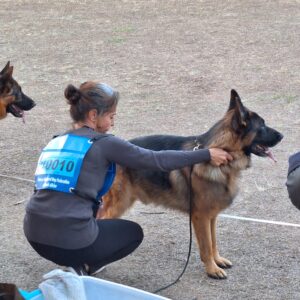
Raising a German Shepherd puppy involves more than just enjoying their playful antics and bonding over training sessions. It’s also about ensuring their physical development is supported without putting undue strain on their developing bodies
Optimal Exercise for German Shepherd Puppies: Balancing Activity with Health
Key to this is understanding the growth phases of puppies, particularly their bones and joints.
Understanding Puppy Growth Plates

German Shepherd puppies have growth plates located near the ends of their long bones, which are crucial in determining the length and shape of the mature bone. These plates are made up of cartilage at birth and gradually harden into bone as puppies grow. However, during their first months, these growth plates are delicate and susceptible to injury if overly stressed by physical activity. This sensitivity necessitates a careful approach to exercise.
The Risks of Improper Exercise
Intense or improper exercise can lead to significant issues, including the development of hip dysplasia. This condition, where the hip joint fails to develop properly, can cause pain and mobility problems throughout a dog’s life. It is influenced by genetic factors but exacerbated by environmental factors such as excessive growth rates, poor nutrition, and inappropriate exercise levels.
Recommended Exercise Guidelines
To promote healthy growth and avoid stress injuries, exercise guidelines for German Shepherd puppies are surprisingly moderate:

Young Puppies (up to 6 months): Activities should be light and short. For instance, an 8-week-old puppy only needs about 10 minutes of physical activity per day, which can include gentle walks on soft terrain, brief training sessions, and playtime with appropriate toys.
Increasing Activity with Age: As puppies grow, their exercise can gradually increase. By 6 months, they might be ready for 30 minutes of physical activity a day. However, intense activities like jogging should still be avoided until their growth plates have fully developed.
Preventing Hip Dysplasia
Preventing hip dysplasia starts with a proper diet that supports a healthy growth rate and joint development. Large breed puppy foods, specifically formulated to prevent rapid growth, can be crucial. Regular veterinary check-ups and mindful observation of your puppy’s behavior and comfort levels during and after exercise can also help catch any early signs of joint problems.
Creating a Healthy Exercise Routine
A well-rounded exercise routine for a German Shepherd puppy includes:
Multiple Short Walks: Spread out the activity throughout the day rather than one long walk.
Controlled Play: Avoid high-impact games like fetch until the puppy is older.
Training for Mental Stimulation: Include training sessions that challenge their mind but not their body.
Final Thoughts
Exercise is vital for a puppy’s development, but it should be appropriately tailored to their age and physical capabilities. By following these guidelines, owners can help ensure their German Shepherd puppies grow into strong, healthy, and active adult dogs.
Remember, the key to a healthy puppy is not just the amount of exercise but the quality and appropriateness of the activities chosen.
Embrace responsible pet ownership by being proactive about your dog’s health and well-being, and consult with your vet to tailor an exercise plan that suits your puppy’s needs.




